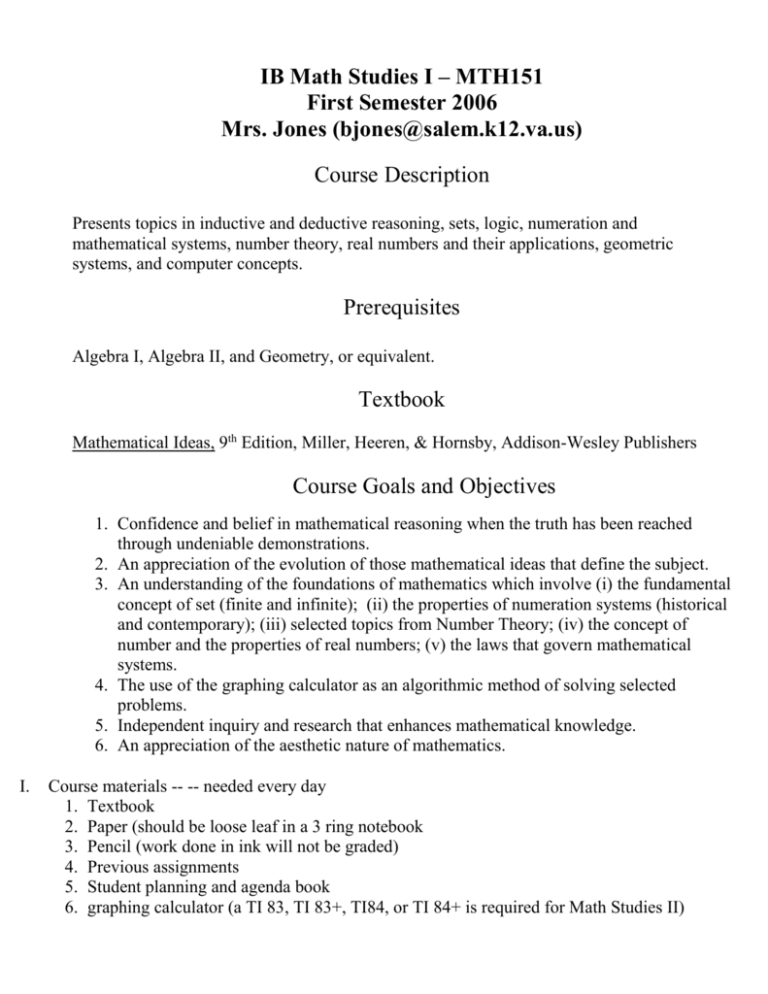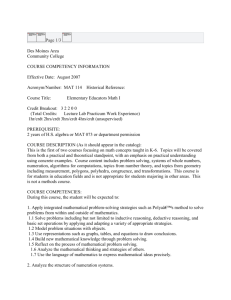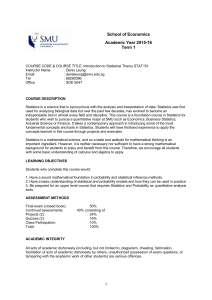IB Math Studies I- MTH 151
advertisement

IB Math Studies I – MTH151 First Semester 2006 Mrs. Jones (bjones@salem.k12.va.us) Course Description Presents topics in inductive and deductive reasoning, sets, logic, numeration and mathematical systems, number theory, real numbers and their applications, geometric systems, and computer concepts. Prerequisites Algebra I, Algebra II, and Geometry, or equivalent. Textbook Mathematical Ideas, 9th Edition, Miller, Heeren, & Hornsby, Addison-Wesley Publishers Course Goals and Objectives 1. Confidence and belief in mathematical reasoning when the truth has been reached through undeniable demonstrations. 2. An appreciation of the evolution of those mathematical ideas that define the subject. 3. An understanding of the foundations of mathematics which involve (i) the fundamental concept of set (finite and infinite); (ii) the properties of numeration systems (historical and contemporary); (iii) selected topics from Number Theory; (iv) the concept of number and the properties of real numbers; (v) the laws that govern mathematical systems. 4. The use of the graphing calculator as an algorithmic method of solving selected problems. 5. Independent inquiry and research that enhances mathematical knowledge. 6. An appreciation of the aesthetic nature of mathematics. I. Course materials -- -- needed every day 1. Textbook 2. Paper (should be loose leaf in a 3 ring notebook 3. Pencil (work done in ink will not be graded) 4. Previous assignments 5. Student planning and agenda book 6. graphing calculator (a TI 83, TI 83+, TI84, or TI 84+ is required for Math Studies II) II. Six-weeks evaluation Grading will be by cumulative points. Letter grades will be assigned according to the Salem City School grading scale. 1. Tests There will be approximately three tests per six week and each will usually count as 100 points 2. Quizzes a. Notebook quizzes will be closed book but opened notebook and consist of working problems or answering with short answer. These will usually count 5-25 points. b. Problem quizzes will be closed book and consist of working problems or answering with short answer. These will usually count 5-25 points. 3. Homework Homework should always be completed conscientiously and on time. In an effort to encourage you to do this, I will check your assignments often. The following scale will usually be used: 0 points for less than 1/5 completed 1 point for more than 1/5 but less than 2/5 completed 2 points for more than 2/5 but less than 3/5 completed 3 points for more than 3/5 but less than 4/5 complete 4 points for more than 4/5 but less than all completed 5 points for all completed Homework will be taken up occasionally and graded as to content. You may receive help if necessary. If you have received help, you must understand the process necessary to solve the problems well enough to explain all of your work in class. Copying will be considered as cheating. All work must be shown. No work means no credit given. III. Class rules: 1. Be in your seat ready to work when the bell rings. If you are late to class, you will need to make up your time by doing extra work with me during your lunch period. 2. Bring all books and materials to class. Either bring your own sharpened pencils to class or sharpen your pencils before the tardy bell rings. You will not be allowed to return to your locker to retrieve “forgotten” items. 3. Sit in your assigned seat each day and remain there until class is dismissed. 4. Follow directions the first time they are given. 5. Conduct yourself in a manner not disruptive to class. Do not bring grooming items, drinks, food, hats, electronic games, etc. into the classroom. IV. Make-up work. 1. Arrangements to make up a test due to an excused absence must be made within two days of your return to school. You should always try to make up your test on the first day back in school. 2. Makeup tests will usually be given during Math Lab (AM or PM). You will need to make arrangements with me prior to the test time in order for your test to be available. It will be easier for you if you are present on test days. 3. If you make an appointment to make up a test and do not make up test at that time, you may receive is a zero on that test. 4. If you are in class the day a test is announced and in class the day that test is given, you are expected to take the test at the regular time. 5. If you are taking a test at a time different from the rest of the class, you should expect a different test. 6. If you are suspended from school or have an unexcused absence, you will be given two days to make up work for each day of unexcused absence. The maximum grade given for such make-up work shall be a “69”. Time extensions will not be granted. 7. If you are absent due to an excused absence, you must make up the work missed within 2 days of your return to school. 8. If you are absent due to a preplanned event (athletic events, field trips, etc.), you should have all work completed on the day following the absence. 9. Homework must be completed by the beginning of class. 10.The responsibility of making arrangements to make up work rest with YOU! V. Conferences and extra help I will be glad to help you at any time you feel you need extra help. If you will see me before or after class, we will arrange a convenient time to work. Help is also available in the math Lab (room 258) which is open before school beginning at 6:30 am and after school beginning at 3:00 pm. All work will be covered in class, but if after class discussion you still have a question or problems, please make me aware of the situation so we can arrange for extra help. Topical Description Chapter 1: The Art of Problem Solving 1.1 Solving Problems by Inductive Reasoning 1.2 An Application of Inductive Reasoning: Number Patterns 1.3 Strategies for Problem Solving 1.4 Calculating, Estimating, and Reading Graphs Extension: Using Writing to Learn About Mathematics Chapter 2: The Basic Concepts of Set Theory 2.1 Symbols and Terminology 2.2 Venn Diagrams and Subsets 2.3 Set Operations and Cartesian Products 2.4 Cardinal Numbers and Surveys 2.5 Infinite Sets and Their Cardinalities Chapter 3: Introduction to Logic 3.1 Statements and Quantifiers 3.2 Truth Tables and Equivalent Statements 3.3 The Conditional and Circuits 3.4 More on the Conditional 3.5 Analyzing Arguments and Euler Diagrams 3.6 Using Truth Tables to Analyze Arguments Chapter 4: Numeration and Mathematical Systems 4.1 Historical Numeration Systems 4.2 Arithmetic in the Hindu-Arabic System 4.3 Conversion Between Number Bases 4.4 Finite Mathematical Systems 4.5 Groups Chapter 5: Number Theory 5.1 Prime and Composite Numbers 5.2 Selected Topics from Numbers Theory 5.3 Greatest Common Factor and Least Common Multiple 5.4 Modular Systems 5.5 The Fibonacci Sequence and the Golden Rule Chapter 6: Real Numbers and Their Representations 6.1 Real Numbers, Order, and Absolute Value 6.2 Operations, Properties, and Applications of Real Numbers 6.3 Rational Numbers and Decimal Representation 6.4 Irrational Numbers and Decimals and Decimal Representation 6.5 Applications of Decimals and Percents Extension: Complex Numbers Plus assorted topics as time permits









